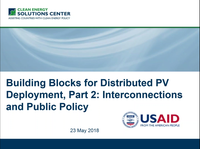Building Blocks for Distributed PV Deployment, Part 2: Interconnection and Public Policy
Due in part to the low cost of photovoltaic system hardware and scalability for deployment, grid-connected distributed photovoltaic (DPV) technologies are increasingly permeating global power markets. While this trend could help substantially reduce the carbon footprint of global power generation, empower citizens across the socio-economic spectrum, and expand local PV markets, there are a number of technical and policy issues—especially in countries that have limited technical resources and need to “get things right” the first time.
Building Blocks for Distributed PV Deployment, Part 1: Goals, Definitions and Compensation
The Clean Energy Solutions Center, in partnership with USAID Distributed PV Program and the National Renewable Energy Laboratory, hosted a no-cost webinar that explores the "building blocks" of establishing a distributed PV program, which include:
- Setting a distributed PV vision, goals, and roles and responsibilities;
- Defining distributed generation;
- Establishing a compensation mechanism;
- Creating interconnection processes, standards, and codes; and
- Providing public policy support as needed.
This webinar is Part 2 in a two-part series. It explores building blocks 4 and 5. The previous webinar explores building blocks 1, 2 and 3. Click here to navigate to the previous webinar in this series.


